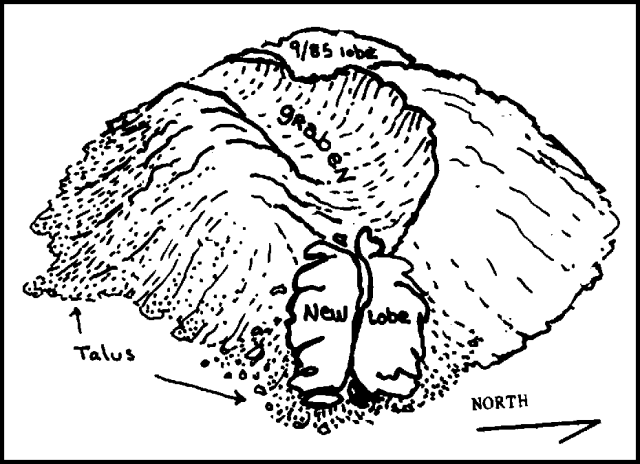Report on St. Helens (United States) — May 1985
Scientific Event Alert Network Bulletin, vol. 10, no. 5 (May 1985)
Managing Editor: Lindsay McClelland.
St. Helens (United States) Strong seismicity accompanies major dome-building episode
Please cite this report as:
Global Volcanism Program, 1985. Report on St. Helens (United States) (McClelland, L., ed.). Scientific Event Alert Network Bulletin, 10:5. Smithsonian Institution. https://doi.org/10.5479/si.GVP.SEAN198505-321050
St. Helens
United States
46.2°N, 122.18°W; summit elev. 2549 m
All times are local (unless otherwise noted)
During mid-May, seismicity and rates of displacement began to increase from background levels. After 8 months of quiescence, a new lobe was extruded onto the composite lava dome, and a major intrusive event further enlarged the dome.
On 13 May, the number of medium- to high-frequency events recorded from the crater seismic station began to increase. Measurements on 16 May indicated that displacement rates on the dome had increased slightly while seismicity continued to build gradually. Several vigorous gas emissions, the first since 24 September 1984, occurred on 17 May from a vent in the NE part of the dome's summit area. No tephra was ejected, and the largest plume rose to just above the crater rim. Seismicity and displacement rates continued to increase, and on 20 May the USGS and University of Washington issued a volcano advisory notice stating that recent changes at the volcano suggested "renewed eruptive activity will begin within the next 2 weeks, possibly within the next few days."
By the 23rd, seismicity had reached high levels. On the 24th, very low-frequency events increased in size and number, although medium- to high-frequency events decreased. Observations made during a night overflight on the 25th at 0030 indicated increased glow from cracks on the dome. Later that morning, the low-frequency earthquakes that typically immediately precede and accompany extrusions had become more numerous, and deformation patterns suggested to USGS scientists that magma had nearly reached the surface of the dome. Observations during the next week were few because of poor weather conditions.
Between 21 and 23 May, a trough-like fracture system began to develop on top of the dome. By 27 May, this graben was 30-50 m wide and had cut across the entire S portion of the dome. Sometime between the 27th and 30th, a new lobe of gas-poor lava was extruded on the SE flank of the dome, near the E end of the newly formed graben. The 80-m-wide lobe extended out of the graben about 100 m down to the crater floor (figure 28). By the 30th, the graben was 400 m long, 30 m deep, and averaged 90-100 m wide. The dome flank S of the graben had been displaced outward.
 |
Figure 28. Sketch of Mt. St. Helens, by Bobbie Myers, looking NW, showing the composite lava dome after formation of the graben and extrusion of the new lobe in May 1985. |
Seismicity continued at very high levels; on the 29th, M 2.5-2.8 events were recorded every few minutes as deep as 1 km below the dome. During past extrusion episodes, seismicity typically decreased sharply when lava reached the surface, but on the 31st, seismicity remained vigorous. Late on 31 May or early on 1 June, a slow decrease in the number of seismic events began. By 5 June seismicity had decreased to moderate levels and had reached background levels by the 17th.
Measurements by USGS scientists on 16 June indicated that the S flank of the dome had moved outward about 70-100 m during the eruption, but that the current displacement rate had by then decreased to about a centimeter per day. A station on the crater floor S of the dome moved 46 m outward and 18 m upward between 17 May and 8 June, but had moved only a few centimeters more by the 16th. These measurements suggested to USGS scientists that about 6-8 x 106 m3 of magma were intruded into the dome during this eruption, the largest single dome-building event since 12 June 1980.
After the vigorous gas emission events of 17 May, vapor emission continued from the same vent during the eruption. However, SO2 emission rates averaged about 40 t/d during May, about the same as the average April rate of 30 ± 5 t/d. On 30 May, the rate increased from background levels to 90 ± 10 t/d, by 2 June to 160 ± 25, and by the 8th to 220 ± 10 t/d. SO2 emission decreased to 165 ± 10 t/d on June 10th and to 60 ± 10 t/d on the 12th.
Equipment to measure H2 emission was installed on top of the dome in January. After 3 months of very low measurements, ambient H2 around the top of the dome began to increase dramatically on 24 May, continued to rise over the next few days, and reached a very high value before the station was destroyed early on the 29th. Because the instrument was not yet calibrated, the measurements cannot be quantified.
Geological Summary. Prior to 1980, Mount St. Helens was a conical volcano sometimes known as the Fujisan of America. During the 1980 eruption the upper 400 m of the summit was removed by slope failure, leaving a 2 x 3.5 km breached crater now partially filled by a lava dome. There have been nine major eruptive periods beginning about 40-50,000 years ago, and it has been the most active volcano in the Cascade Range during the Holocene. Prior to 2,200 years ago, tephra, lava domes, and pyroclastic flows were erupted, forming the older edifice, but few lava flows extended beyond the base of the volcano. The modern edifice consists of basaltic as well as andesitic and dacitic products from summit and flank vents. Eruptions in the 19th century originated from the Goat Rocks area on the N flank, and were witnessed by early settlers.
Information Contacts: D. Swanson, C. Newhall, S. Brantley, K. McGee, J. Sutton, B. Myers, USGS CVO, Vancouver, WA; C. Jonientz-Trisler, University of Washington.

